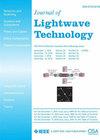Development of a High-Energy Picosecond Mid-Infrared Laser Based on ZnGeP2 Optical Parametric Generator/Amplifier
IF 4.1
1区 工程技术
Q2 ENGINEERING, ELECTRICAL & ELECTRONIC
引用次数: 0
Abstract
We developed a high-energy picosecond mid-infrared laser based on ZnGeP2 (ZGP) optical parametric generator (OPG)/optical parametric amplifier (OPA), operating at a pulse repetition frequency (PRF) of 1 kHz. The laser system was equipped with a 2.09 μm high-energy picosecond laser amplification system as the pump source. The pump source itself incorporated a gain-switched laser diode (GSLD) as the seed. By employing a holmium:yttrium-aluminum-garnet (Ho:YAG) regenerative amplifier (RA) and multi-stage power amplifiers, we successfully achieved a maximum pulse energy of 26.2 mJ at a wavelength of 2.09 μm. Initially, using a ZGP OPG and a one-stage OPA, we achieved mid-infrared laser output of over 6.4 mJ. However, the corresponding beam quality deteriorated, with beam quality factors (基于ZnGeP2光参量产生/放大器的高能皮秒中红外激光器的研制
研制了一种基于ZnGeP2 (ZGP)光参量发生器(OPG)/光参量放大器(OPA)的高能皮秒中红外激光器,工作脉冲重复频率(PRF)为1khz。激光系统采用2.09 μm高能皮秒激光放大系统作为泵浦源。泵浦源本身包含一个增益开关激光二极管(GSLD)作为种子。采用钬钇铝石榴石(Ho:YAG)再生放大器(RA)和多级功率放大器,在波长2.09 μm处获得了最大脉冲能量26.2 mJ。最初,使用ZGP OPG和一级OPA,我们实现了超过6.4 mJ的中红外激光输出。然而,相应的光束质量变差,x和y方向的光束质量因子(M2)均超过50。为了缓解这个问题,我们将ZGP OPG与两级OPA配置相结合,从而获得超过6 mJ的中红外激光输出,并在各自方向上提高了17.2和14.7的光束质量因子。值得注意的是,该系统的整体光-光转换效率(OOCE)超过了40%,其中第二阶段OPA的OOCE超过了45%。
本文章由计算机程序翻译,如有差异,请以英文原文为准。
求助全文
约1分钟内获得全文
求助全文
来源期刊

Journal of Lightwave Technology
工程技术-工程:电子与电气
CiteScore
9.40
自引率
14.90%
发文量
936
审稿时长
3.9 months
期刊介绍:
The Journal of Lightwave Technology is comprised of original contributions, both regular papers and letters, covering work in all aspects of optical guided-wave science, technology, and engineering. Manuscripts are solicited which report original theoretical and/or experimental results which advance the technological base of guided-wave technology. Tutorial and review papers are by invitation only. Topics of interest include the following: fiber and cable technologies, active and passive guided-wave componentry (light sources, detectors, repeaters, switches, fiber sensors, etc.); integrated optics and optoelectronics; and systems, subsystems, new applications and unique field trials. System oriented manuscripts should be concerned with systems which perform a function not previously available, out-perform previously established systems, or represent enhancements in the state of the art in general.
 求助内容:
求助内容: 应助结果提醒方式:
应助结果提醒方式:


